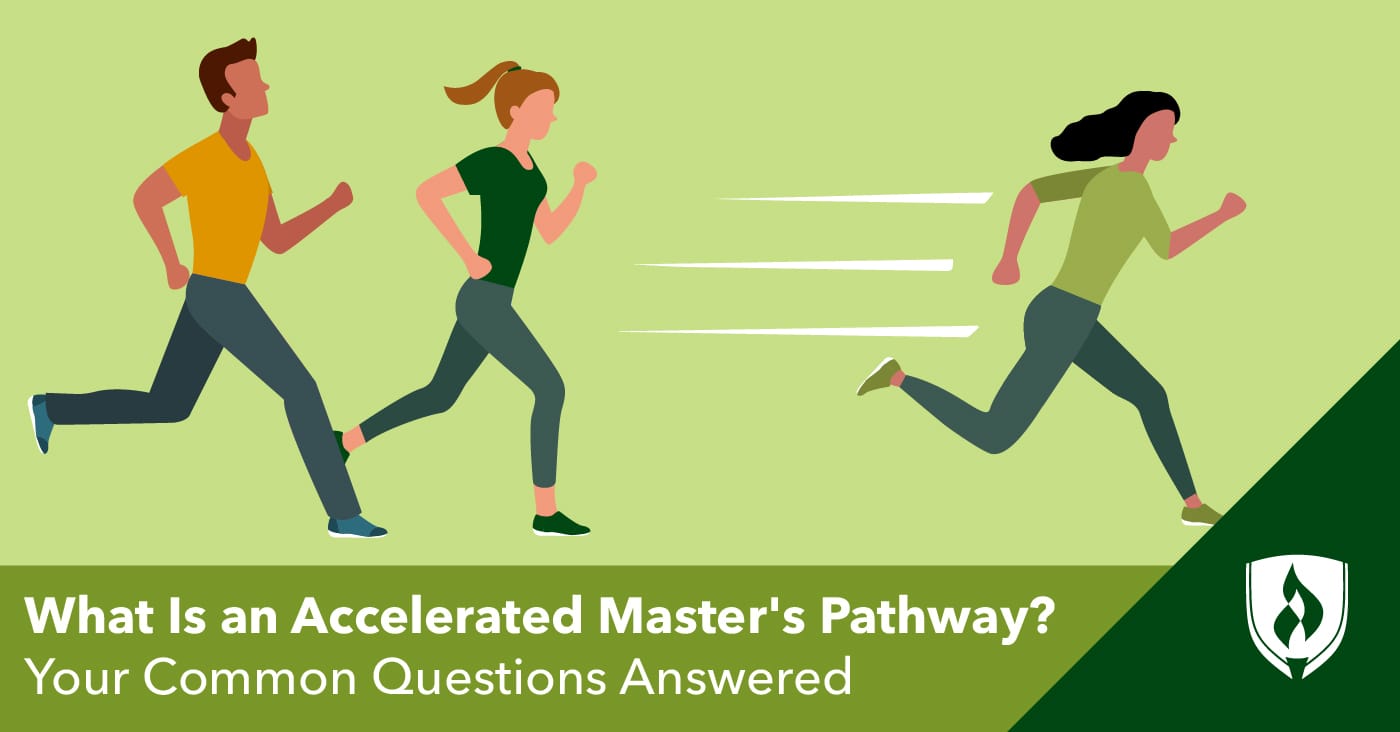
It’s no secret the world of higher education can be full of confusing or unfamiliar terms—just ask the provost about the status of your cohort’s matriculation. All vocabulary humor aside, it’s true that while you might be able to navigate your academic experience without knowing an exact definition of every single term, some really do merit a closer look—and that’s certainly the case with the phrase “accelerated Master’s pathway.”
This academic option can provide a significant savings opportunity for you if you’re considering earning a graduate degree in the future. While the opportunity to potentially save time and money on the way to earning a graduate degree sounds appealing, you’re not alone if you have some questions about how it all works. In this article, we’ll explain what the accelerated Master’s pathway option means at Rasmussen University and answer some of the most common questions you may have.
What is an accelerated Master’s pathway?
As the name implies, the accelerated Master’s pathway offering at Rasmussen University provides an avenue for students to earn a Master’s degree in less time. This is accomplished by allowing qualified students in select programs to swap out a number of Bachelor’s degree-level courses with compatible Master’s degree courses. This allows motivated students to get a head start on their graduate degree studies.
For some program combinations, that could mean completing up to six graduate degree courses during the time a student would typically finish off their Bachelor’s degree. While not exactly the same, you can think of it as a similar concept to when high schools offer courses to qualified students that can be accepted for college credit.
How much could I save on my Master’s degree?
The exact answer to this will depend on the programs you intend to complete. Some combinations offer one graduate-level course through this offering, but others allow you to complete up to six. For context, imagine you’re a full-time graduate student taking two courses per quarter. By completing four courses through the accelerated Master’s pathway, you could shave six months off of your total time in graduate school.1
It’s not just time you can save, either. The accelerated Master’s pathway can provide financial savings as well. In total, this has the potential to amount to savings ranging from $1,025 up to $6,150, depending on the program you pursue.1
What if I’m not sure about earning a graduate degree?
Committing to earning a graduate degree is a big decision that you might not feel ready to make right now. The good news is there’s really no drawback to exploring this option as you’re not locked in from day one. If you’re even remotely interested in the prospect of earning a graduate degree, you can let your admissions advisor know up front, and when the time comes for making that decision later on in your program, you’ll have the option to discuss it further.
If you’re not sure about earning a graduate degree at that time, this still gives you the option to test the waters of graduate school. If you decide it’s not right for you, that’s okay! As long as things go to plan academically, you’ll at least know more about the experience and have some graduate school academic credit in your back pocket if you change your mind down the road.
Is everyone eligible for the accelerated Master’s pathway?
This is an important factor to keep in mind. To be eligible for these graduate-level courses, you will still need to meet certain education requirements that are comparable to what other graduate students need to fulfill. If you intend on pursuing this option, be sure to communicate with your academic advisor to ensure you’re on track.
What happens if I struggle in my graduate courses?
Graduate coursework is clearly a step up, so it’s understandable if you’re a little wary of the academic rigor. While your academic performance in Bachelor’s degree courses is a strong indicator of your readiness for graduate courses, you’ll still want to be up front about any doubts you may have with your academic advisor. They may be able to talk you through course expectations and give you a better idea of your potential workload.
That said, if you do enroll and feel overwhelmed, the same rules apply to these courses like any other courses. You’ll have a window of time early on to drop the course from your schedule without impact to your academic transcript. Just keep in mind that you will still need to eventually fulfill the same credit requirements in order to graduate.
Will these courses be on the same academic schedule?
Yes! Graduate courses will begin and end at the same time as your undergraduate courses, so there’s no need to worry about potential scheduling issues. Additionally, many of these graduate courses are offered in a competency-based education format which gives you additional flexibility for how you tackle your coursework.
Explore your education advancement options
Now that you’re up to speed on what an accelerated Master’s pathway is and the details of how this offering works, are you interested in learning more? Don’t miss out on this opportunity to potentially save time and money on your graduate education.1
You can visit the accelerated Master’s pathway page to learn more about the eligible undergraduate and graduate program pairings or request more information to get into contact with an admissions advisor.
1Number of eligible courses varies by program and ranges from one to six courses. Time and cost savings are dependent on the eligible student enrolling in and completing both the Bachelor’s and Master’s degrees at Rasmussen University through the accelerated Master’s pathway. Completion time is dependent on the number of transfer credits accepted and the number of courses completed each term. Please speak to an admissions advisor for details. Programs are not available to residents of all states. Please speak with an admissions advisor to determine your eligibility for enrollment.




